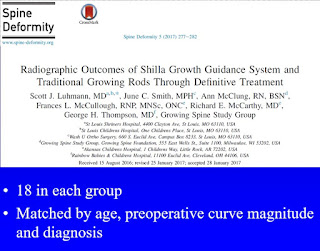This is a question parents commonly ask me in the office. The question is a fair, reasonable
question. So why is it so hard for me to
give an answer? Well…..EOS is a
problem which has many facets or things which need to be considered to be able
to optimally answer the question. Every
child and every spinal deformity is unique: rib deformities (brown circle),
spine/vertebral pathology/problems (purple circle), and differing underlying
diagnoses (yellow circle) all need to be considered. In addition, patient age, location of the
deformity, patient height and weight, bone quality, etc…. also comes into play
when we consider how to surgically treat a patient.
question. So why is it so hard for me to
give an answer? Well…..EOS is a
problem which has many facets or things which need to be considered to be able
to optimally answer the question. Every
child and every spinal deformity is unique: rib deformities (brown circle),
spine/vertebral pathology/problems (purple circle), and differing underlying
diagnoses (yellow circle) all need to be considered. In addition, patient age, location of the
deformity, patient height and weight, bone quality, etc…. also comes into play
when we consider how to surgically treat a patient.
…and because each patient is unique….….
And for EOS surgery the three surgical “tools” we are going
to talk about are:
to talk about are:
1.
Traditional Growing Rods (TGR)
Traditional Growing Rods (TGR)
2.
Magnetically-Controlled Growing Rods or MAGEC (MCGR)
Magnetically-Controlled Growing Rods or MAGEC (MCGR)
3.
Growth Guidance Surgery (GGS)
Growth Guidance Surgery (GGS)
Like many of the decisions we make every day in life,
identifying the goals or desired outcome of our actions is important. For surgery we need to identify what “success”
looks like….because if we don’t know what our goals are….we cannot determine
if our surgery achieved it goals. Below
is a short list of the “Goals of EOS surgery”.
identifying the goals or desired outcome of our actions is important. For surgery we need to identify what “success”
looks like….because if we don’t know what our goals are….we cannot determine
if our surgery achieved it goals. Below
is a short list of the “Goals of EOS surgery”.
So let’s look one-by-one at each one of these goals to see
how the three most common surgeries for EOS compare. Below is study we published comparing Growth
Guidance Surgery to Traditional Growing Rods.
how the three most common surgeries for EOS compare. Below is study we published comparing Growth
Guidance Surgery to Traditional Growing Rods.
So this study reported similar outcomes for scoliosis curve
correction, spinal height and surgical complications, with fewer surgeries in
the Growth Guidance Surgeries compared to Traditional Growing Rods.
correction, spinal height and surgical complications, with fewer surgeries in
the Growth Guidance Surgeries compared to Traditional Growing Rods.
FYI: Distraction-based constructs are Traditional Growing Rods and Magnetically-Controlled Growing Rods
When we look at our “Goals of EOS Treatment” you see how
favorably Growth Guidance Surgery stacks up against Traditional Growing Rods
and Magnetically-Controlled Growing Rods.
When I have a child who needs surgery I consider each of these methods
of treatment, but the first one I think of is Growth Guidance, followed by
Magnetically-Controlled Growing Rods and if neither of these surgeries can be
performed I opt for Traditional Growing Rods.
favorably Growth Guidance Surgery stacks up against Traditional Growing Rods
and Magnetically-Controlled Growing Rods.
When I have a child who needs surgery I consider each of these methods
of treatment, but the first one I think of is Growth Guidance, followed by
Magnetically-Controlled Growing Rods and if neither of these surgeries can be
performed I opt for Traditional Growing Rods.
Below is a typical patient, who at 9 years of age underwent
surgery and is shown 3 years after surgery.
He only has had one surgery so far……
surgery and is shown 3 years after surgery.
He only has had one surgery so far……
The last item I want to comment about is another question I
sometimes get asked by parents who have seen other pediatric spine before
seeing me: Why haven’t other surgeons offered Growth Guidance as a treatment
option for my child? Growth Guidance
surgery has been around since the early 2000s, yet it has not caught on as a
popular surgical technique, so it’s not like this is new procedure. The main issue is Growth Guidance Surgery is
a more difficult procedure to perform than Traditional or
Magnetically-Controlled Growing Rods and it has been taught to pediatric
orthopaedic surgeons at only a couple of medical centers in the U.S. with any
frequency (Little Rock, Arkansas and St. Louis, Missouri).
sometimes get asked by parents who have seen other pediatric spine before
seeing me: Why haven’t other surgeons offered Growth Guidance as a treatment
option for my child? Growth Guidance
surgery has been around since the early 2000s, yet it has not caught on as a
popular surgical technique, so it’s not like this is new procedure. The main issue is Growth Guidance Surgery is
a more difficult procedure to perform than Traditional or
Magnetically-Controlled Growing Rods and it has been taught to pediatric
orthopaedic surgeons at only a couple of medical centers in the U.S. with any
frequency (Little Rock, Arkansas and St. Louis, Missouri).








